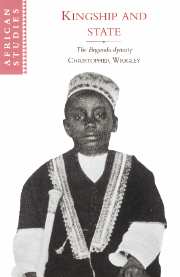Book contents
- Frontmatter
- Contents
- List of illustrations
- Preface
- Notes on language
- List of abbreviations
- 1 Preamble
- 2 The story and its making
- 3 Introduction to myth
- 4 Introduction to Buganda
- 5 The remoter past
- 6 Genesis
- 7 The cycle of the kings
- 8 Fragments of history
- 9 Foreign affairs
- 10 The making of the state
- 11 Reflections
- Notes
- Bibliography
- Index
- Other books in the series
8 - Fragments of history
Published online by Cambridge University Press: 12 January 2010
- Frontmatter
- Contents
- List of illustrations
- Preface
- Notes on language
- List of abbreviations
- 1 Preamble
- 2 The story and its making
- 3 Introduction to myth
- 4 Introduction to Buganda
- 5 The remoter past
- 6 Genesis
- 7 The cycle of the kings
- 8 Fragments of history
- 9 Foreign affairs
- 10 The making of the state
- 11 Reflections
- Notes
- Bibliography
- Index
- Other books in the series
Summary
The kings who married many wives
After Mulondo there is an area of some obscurity and confusion, in which even the different strands within the orthodox tradition are not completely in agreement about the sequence of the kings. According to Kaggwa, Mulondo grew up but did not grow old, and he was followed on the throne by his two younger brothers, Jjemba and Ssuuna. Only after that generation was complete did his son Kamaanya (Sse-kamaanya, ‘Kamaanya the First’) secure the kingship. It then passed to Ssuuna's son Kimbugwe before reverting to Kateregga son of Kamaanya. Older authorities, on the other hand, had placed Kamaanya directly after Mulondo, and had said nothing about the genealogical relationships, while Father Achte made Ssekamaanya the son of Jjemba. Kaggwa's arrangement certainly seems the most plausible, since it implies a system of fraternal succession followed by rotation between two or more branches of the royal house, which commonly occurs in Africa. Kiwanuka maintains that since Mulondo, Jjemba and Ssuuna are all credited with reigns of some length they cannot all have been brothers and that Ssuuna at least probably belonged to a different generation. However, detailed argumentation is almost certainly pointless, since it is very unlikely that we are dealing, at this stage, with clearly remembered dynastic history. Mulondo, after all, was not a person but the mask of a particular phase of kingship, and his ‘brothers’ probably had no more individual reality.
Certainly very little is told of them. Of Jjemba we know only that he was especially devoted to his favourite wife, for whom he began the cemetery at Luggi in which all later childbearing royal wives would be buried.
- Type
- Chapter
- Information
- Kingship and StateThe Buganda Dynasty, pp. 169 - 191Publisher: Cambridge University PressPrint publication year: 1996

